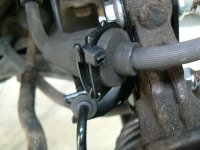Today has been "set up" day. When I checked Becky over before starting on the struts I measured the toe setting using my "trusty" home made tracking gauge. Whenever I'm doing anything on a car I like to know where things stand before I start. Then if there is an unexpected outcome it gives me a reference for checking. (one reason I always do a whole vehicle scan with
MES first off when I'm doing a service). The result I got was that she was toed out around four and a half to five mm. Recommended setting is parallel - ie Zero mm.
Before I start in here can I recommend that anyone wanting to fully understand what I'm talking about types in "Jock's tracking gauge" into the search bar at the top of the page and read the thread. If you're just being entertained by this post, by all means read on. - let's call Jock's tracking gauge "JTG" from here on.
I'm now going to try to set up the toe on Becky. First thing is a very thorough examination of suspension and steering components (more in JTG). Assuming all is found to be ok next is to check the wheel rims (or perhaps wheel "lands" - the bit of the wheel the tyre bead sits on) run "true" when the wheel is rotated. This is the datum point from which your readings are taken, if the wheel "wobbles", for what ever reason. (see JTG) when rotated you have no chance of obtaining accurate readings and will just be wasting your time to even try.
Here's me checking Becky
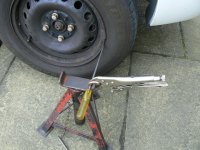
The screwdriver (or whatever you want to use) is clamped securely to the stand, placed so it lightly rubs against the wheel rim and the wheel is rotated. The wheel must run true. If it doesn't either try the land - in which case you will use this for your datum reference or swop another wheel to this position and try again. When you've got a satisfactory wheel on both front hubs put the car back on the ground (you had to jack it up to spin the wheels of course) and go a run round the block to settle the suspension down. If you find most of the rim runs "true" but a small are does not then just mark it (I use blackboard chalk) and you can still use that wheel as long as you don't involve the chalked area.
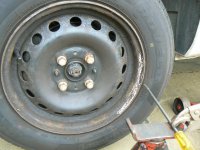
Now approach your chosen flat surface where you are going to take the measurements. The car must be driven forward and brought to a halt without running backwards so that all forces acting on the suspension are as they are when you are driving along. The "fixed" end of the tool is now locked up with the end in line with the centre of the axle and a distance piece cut to the same length (I used a piece of doweling). It's very important that this fixed end is locked off securely. If it moves your readings will be nonsense.
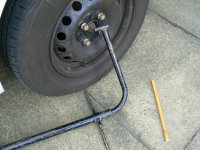
Now the whole tool is slid under the front of the car. The fixed end is on the right here (N/S and it's stop end is placed against the outer wheel rim (or land if you've chosen that as a datum point)
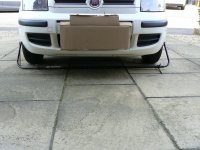
Now the sliding end is placed against the outer rim of the other (O/S) front wheel, using the distance piece (doweling) to get it to exactly the same height as the fixed end on the N/S. This is very important as wheel camber will make a nonsense of any readings you take if both heights are not identical.

Now slide the marking cursor along until the scribing line is over the piece of masking tape (more in JTG) and securely lock it off. As with the fixed pointer, if this subsequently moves your readings are toast! Now take a sharp pencil and, holding it at right angles to the masking tape (to avoid parallax always hold the pencil at right angles) make a line on the tape.
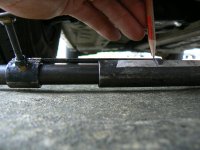
Now "wheech" the whole tool out from under the car - careful not to bang either of the lock off clamps - and slide it in behind the wheels. Now the fixed end is going to be on the O/S and the sliding end on the N/S. Repeat the whole exercise. A lot of care is needed to be sure that both ends of the tool are in contact with the wheel rims before scribing your line and I always make some sort of mark to remind me which line is the "in front line" and which is the "behind line". Now "wheech" the whole thing out and have a look at your lines. The first result I got was this
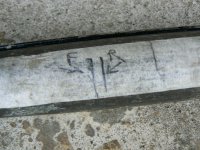
Which shows the wheels to be toed out by around 4 to 5 mm - obviously been like this since I bought her. Mr Haynes tells me it should be zero (parallel). So, as she's set up just now the N/S (LH) wheel is trying to go slightly left and the O/S (RH) wheel is trying to go slightly right. I would expect to see the front tyres with excessive wear on the inside shoulders if she's run for any length of time like this but the dealer had put a new tyre on the left front and swapped the best of the rest to the right front so I couldn't really check but, interestingly one of the rears looks like this
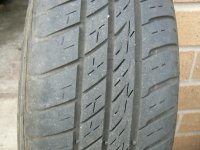
Bet it was on the front before he messed about with it for sale. Dealers will often put the best tyres on the front because if you stop on his forecourt with the steering on a lock the tread looks good!
To get rid of all this unwanted toe out we need to adjust the effective length of the track rods (which connect the ends of the rack to the track rod ends.) They are threaded into the trackrod ends and secured with a lock nut (often corroded nearly solid) the end in the rack is a ball joint so can spin round as you turn the track rod itself (after slackening the lock nut)


On the Panda the rack is behind the centre line (axle line) of the front wheels so the track rods need to be screwed out of the trackrod ends a wee bit. But by how much and do both need to be turned the same amount? Well the first thing to find out is whether the steering wheel is centred on the rack. Do this (I like to have the front end off the ground to minimise stress on the steering components) by sitting in the drivers seat, turn to full lock (doesn't matter which way) and make a wee mark (I like blackboard chalk because you can rub it out easily) on the wheel at 12 o'clock and also, in the same position, on the top of the instrument binnacle. Now go to full lock the other way and mark the wheel, wherever it stops, opposite the binnacle mark. You now have two marks on the wheel and know how many turns it took to get there - half way between is the straight ahead position OF THE STEERING RACK. If the wheel is correctly fitted to the column, with THE RACK in this position the steering wheel should also be straight ahead. If it's not you've got a problem and I'm not dealing with that here. Your steering needs to be centred like this before you start adjusting toe if you are to end up with the wheel straight when you're going straight!
Next thing to check is whether, with the rack centred, both wheels are pointing ahead on equal angles. to do this you need a long straight edge. It doesn't need to be microscopically straight but it does need to look straight without any obvious bends/kinks. I use a length of Dexion but a nice straight plank will do just fine. If you.ve had the car up in the air doing your checks you'll need to go round the block again and end up rolling forward to a stop with the STEERING WHEEL STRAIGHT AHEAD. now put your straight edge down one side of the car with one end on the forward sidewall of the rear tyre and the other right across both edges of the front tyre
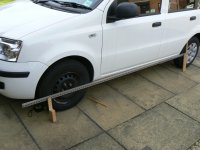
So that you can see the contact between the front and rear sidewalls - keep the other end of the straight edge in touch with the front sidewall of the rear tyre whilst doing this.
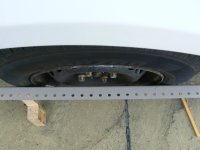
As you can see the result for Becky is that it's touching both front and rear. Note this (measure any gap and whether it's front or rear) and repeat the exercise on the other side. If the steering is properly centred you should have, with the steering wheel in the straight ahead position, an equal result on both sides (N/S mirror image of O/S) and this is what we get on Becky so that's a good start. But the straight edge is touching both front and back on both front tyres and we know we've got a measured toe out of around 4 to 5 mm. How can this be? surely we should be seeing a gap at the rear sidewalls on both sides because with the setting toed out the front left wheel is going slightly left and the front right is going slightly right? The answer is really quite simple. The front track is wider than the rear (that means that measured across the car the front wheels are further apart than the rears!
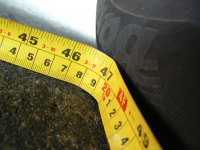
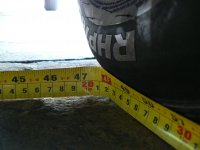
Think about it for a minute and you'll get it. Ok so Becky's steering is centred and both wheels are pointing out by the same amount so we need to turn them in towards each other by identical amounts on each side. If the straight edge check shows a difference side to side then you'll have to adjust one side more, or less, than the other to equalize them. So, on Becky, I now slacken the lock nuts on the track rods and turn both sides so as to move the track rod ends out (effectively making the arms longer). How much by? good question. It's very much "suck it and see" but as you do it more often you get a feel for it. I choose to rotate each arm three quarters of a turn. Mark the arm with chalk before you start, it's very easy to get confused and loose your perception of how much you've twisted the arm. Watch also that you're not twisting up the steering rack gator. You may need to slacken any clips if fitted and a squirt of something like WD40 helps it to spin without gripping the rubber. Now lightly lock up the lock nut - to eliminate any backlash in the threads - and do your toe measurements again. I found I'd gone from around 5mm toe out to just under 1mm toe in.
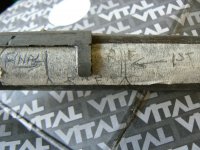
Slacken the lock nuts (that's why you just "nip" them up during adjustment so they are going to slacken easily) and a wee turn in the other direction - I went less than a quarter turn - lock it all up lightly again and remeasure. Both pencil marks are now coming out on top of each other so I'm now at parallel! Yippee!
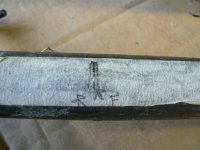
That was quite an easy one, I've sometimes spent hours doing these adjustments where the wheel is not centred on the column and someone has made unequal adjustments side to side to compensate when what they should have done was centre the wheel on the column before doing anything else. I notice cars with EPS are tending to have a column with one master spline so the wheel will only fit in one position - Halleluja!!!
Now lock the track rod nuts up good and tight and give them a good slaistering with Coppaslip so they'll be easier to undo next time.
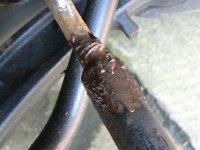
Lastly, do the straight edge check again. Steering wheel straight. gaps should be equal mirror images on both front wheels. but prehaps it's easier to just go a drive down the road and see if the steering wheel is centred when you are going in a straight line. If it's not you have my permission to turn the air blue (I've been known to) because you're going to have to go back and "fiddle" some more. If you've taken care and done it right though this method works every time.
Still think those bolts are needlessly long though?
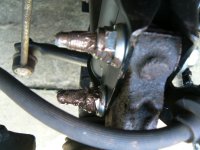
I am particularly pleased with the way Becky sits now. No longer does she suffer front end "droop" Ride height - Axle centre vertically to wheel arch - on the front wheels before was 342 mm on the N/S and 345 mm on the O/S. Now, after a good run around and a few, gently negotiated, speed bumps she sits at 360 mm both sides.

What a handsome lass she looks!


